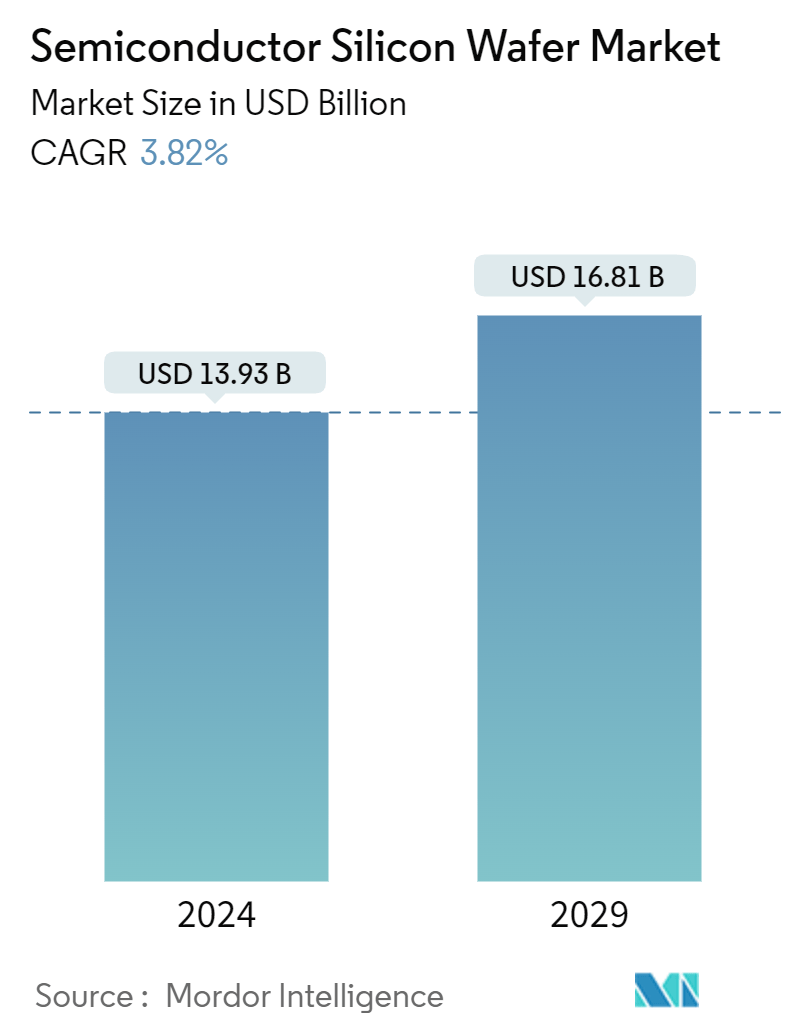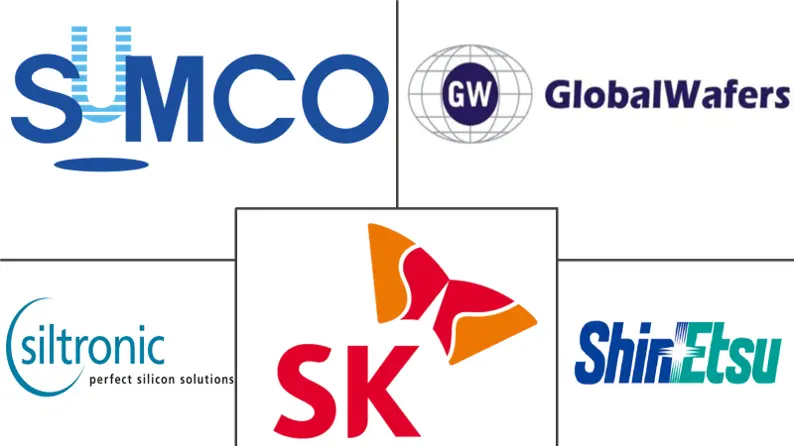Market Size of Semiconductor Silicon Wafer Industry

| Study Period | 2019 - 2029 |
| Market Size (2024) | USD 13.93 Billion |
| Market Size (2029) | USD 16.81 Billion |
| CAGR (2024 - 2029) | 3.82 % |
| Fastest Growing Market | Asia Pacific |
| Largest Market | Asia Pacific |
Major Players*Disclaimer: Major Players sorted in no particular order |
Semiconductor Silicon Wafer Market Analysis
The Semiconductor Silicon Wafer Market size is estimated at USD 13.93 billion in 2024, and is expected to reach USD 16.81 billion by 2029, growing at a CAGR of 3.82% during the forecast period (2024-2029).
The Semiconductor Silicon Wafer Market size is estimated at USD 13.93 billion in 2024, and is expected to reach USD 16.81 billion by 2029, growing at a CAGR of 3.82% during the forecast period (2024-2029).
- Semiconductor silicon wafer remains the core component of many microelectronic devices and forms the cornerstone of the electronics industry. With digitization and electronic mobility being the current trends in the technology landscape, these products are finding applications in many devices. Also, the demand for small-sized gadgets has increased the need for more functionalities from a single device. This means that an IC chip should now house more transistors to support more features.
- The semiconductor industry has been a significant driver behind critical innovations in significant sectors like electronics, automobiles, and automation, with semiconductor technology emerging as the building block of all modern technologies. The advancements and innovations in this field are immediately impacting all downstream technologies.
- Foundries are increasingly investing in new advanced packaging techniques, especially silicon wafer-based. Foundry vendors are researching improving transistor density with techniques like utilizing two-dimensional materials instead of silicon as the channel to develop Monolithic 3D Integrated Circuits. For instance, TSMC's chip on wafer on Substrate technology developed the world's largest silicon interposer that featuring room for two massive processors combined with 8 HBM memory devices in a package.
- Advancements in wearable devices will create massive growth opportunities for market vendors. According to Siemens, industrial wearables could be a massive market as these devices enhance quality and safety in the processing industry. According to Zebra Technologies Corporation, 40-50% of manufacturers globally are expected to adopt wearables by 2022. Also, the demand for small-sized gadgets has raised the need for more functionalities from a single device. This indicates that an IC chip should now house more transistors to support more functionalities.
- Favorable government policies across emerging economies like China created enormous opportunities for the semiconductor industry, which is expected to expand the semiconductor silicon wafer market during the forecast period. For instance, the policy framework published by the State Council of the People's Republic of China aims to make advanced semiconductor packaging solutions a technology priority across the semiconductor industry.
Semiconductor Silicon Wafer Industry Segmentation
Silicon wafers are thin slices of pure or doped silicon cut from silicon ingots. Their thicknesses range from a few millimeters to a few microns and can be tuned according to the application through thinning processes. They are extensively used in smartphones, smartwatches, computers, tablets, gas sensors, and smart home sensors.
The semiconductor silicon wafer market is segmented by diameter (less than 150 mm, 200 mm, 300 mm, and above), product (logic, memory, and analog), application (consumer electronics, industrial, telecommunication, and automotive), and geography. The market sizes and forecasts are provided in terms of value (USD) for all the above segments.
| By Diameter | ||||
| ||||
| 200 mm | ||||
| 300 mm and above (450mm, etc.) |
| By Product | |
| Logic | |
| Memory | |
| Analog | |
| Other Products |
| By Application | ||||
| ||||
| Industrial | ||||
| Telecommunication | ||||
| Automotive | ||||
| Other Applications |
| By Geography | |
| North America | |
| Europe | |
| Asia | |
| Australia and New Zealand |
Semiconductor Silicon Wafer Market Size Summary
The semiconductor silicon wafer market is a pivotal segment within the electronics industry, serving as the foundational component for numerous microelectronic devices. As the demand for digitization and electronic mobility surges, these wafers are increasingly integral to the functionality of compact gadgets, necessitating more transistors on integrated circuit chips to accommodate enhanced features. The semiconductor industry is a catalyst for innovation across various sectors, including electronics, automobiles, and automation, with advancements in wafer technology directly influencing downstream applications. Foundries are investing in advanced packaging techniques and exploring new materials to improve transistor density, which is crucial for developing more sophisticated integrated circuits. The market is also witnessing significant growth opportunities in wearable devices, driven by favorable government policies in emerging economies like China, which prioritize advanced semiconductor packaging solutions.
North America is a key player in the semiconductor silicon wafer market, with fabless semiconductor companies in the region being major customers for wafer foundries. The region's robust electronics industry and the establishment of new wafer foundries, such as TSMC's planned 12-inch wafer plant, underscore its importance. The demand for semiconductor wafers is further propelled by the automotive sector's shift towards electric vehicles and self-driving technology, which require high-performance integrated circuits. The market is competitive and consolidated, with a few dominant players driving innovation through technological advancements and strategic partnerships. Recent developments, such as Wolfspeed's expanded silicon carbide wafer supply deal and Tata Electronics' new fabrication facility in India, highlight the industry's commitment to adopting advanced semiconductor technologies.
Semiconductor Silicon Wafer Market Size - Table of Contents
-
1. MARKET DYNAMICS
-
1.1 Market Overview
-
1.2 Industry Value Chain Analysis
-
1.3 Industry Attractiveness - Porter's Five Forces Analysis
-
1.3.1 Bargaining Power of Suppliers
-
1.3.2 Bargaining Power of Consumers
-
1.3.3 Threat of New Entrants
-
1.3.4 Threat of Substitute Products
-
1.3.5 Intensity of Competitive Rivalry
-
-
1.4 Market Drivers
-
1.4.1 Growing Demand from Non-Traditional End-User Verticals and Steady Rise in Wearable Sales
-
-
1.5 Market Challenges
-
1.5.1 Operational Challenges Faced by the Producers Owing to High Cost and Dynamic Nature of End-User Demand
-
-
1.6 Key Cost Considerations for Silicon Wafer
-
1.7 Impact of COVID-19 on the Semiconductor Silicon Wafer Industry
-
-
2. MARKET SEGMENTATION
-
2.1 By Diameter
-
2.1.1 Less than 150 mm
-
2.1.1.1 By Product (Logic, Memory, Analog, and Other Products)
-
2.1.1.2 Vendor Ranking Analysis
-
-
2.1.2 200 mm
-
2.1.3 300 mm and above (450mm, etc.)
-
-
2.2 By Product
-
2.2.1 Logic
-
2.2.2 Memory
-
2.2.3 Analog
-
2.2.4 Other Products
-
-
2.3 By Application
-
2.3.1 Consumer Electronics
-
2.3.1.1 Mobile/Smartphones
-
2.3.1.2 Desktop, Notebook, and Server PCs
-
-
2.3.2 Industrial
-
2.3.3 Telecommunication
-
2.3.4 Automotive
-
2.3.5 Other Applications
-
-
2.4 By Geography
-
2.4.1 North America
-
2.4.2 Europe
-
2.4.3 Asia
-
2.4.4 Australia and New Zealand
-
-
Semiconductor Silicon Wafer Market Size FAQs
How big is the Semiconductor Silicon Wafer Market?
The Semiconductor Silicon Wafer Market size is expected to reach USD 13.93 billion in 2024 and grow at a CAGR of 3.82% to reach USD 16.81 billion by 2029.
What is the current Semiconductor Silicon Wafer Market size?
In 2024, the Semiconductor Silicon Wafer Market size is expected to reach USD 13.93 billion.


